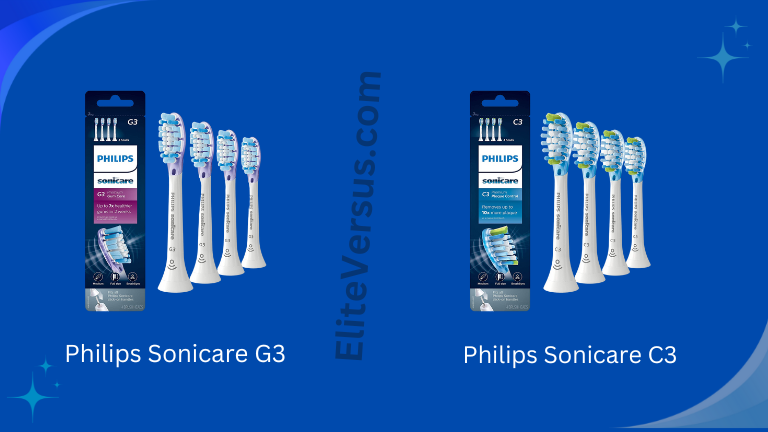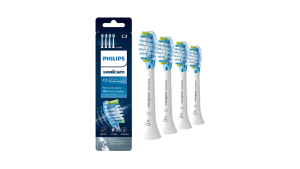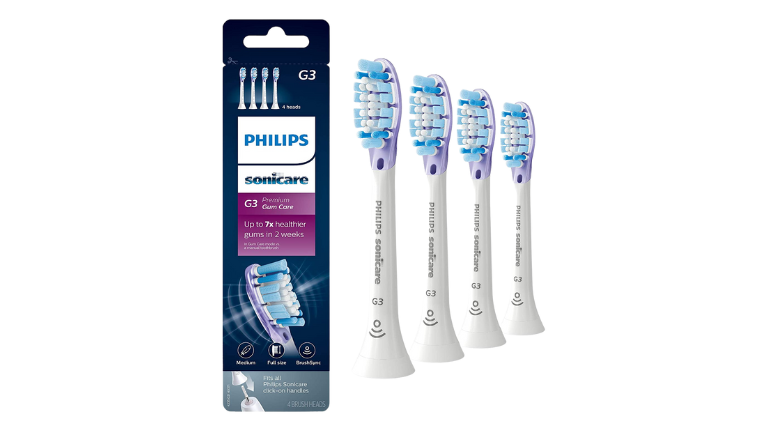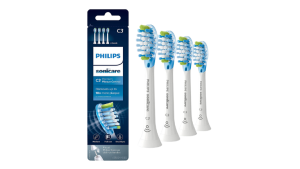Philips Sonicare G3 vs Philips Sonicare C3 – Detailed Blog
Philips Sonicare G3 vs Philips Sonicare C3: In this post, we’ll be looking at two of Philips’ most popular electric toothbrushe Head, the Sonicare G3 and the Sonicare C3, and discussing their relative merits and drawbacks.
Soft: Extra Soft
Remove Gum: upto 10x More Plaque
Replace Brush Head: Every 3 Month
Weight: 18 Grams
Soft: Soft
Remove Gum: upto 10x More Plaque
Replace Brush Head: Every 3 Month
Weight: 13 Grams
The purpose of this article is to assist you in choosing the best toothbrush for your oral hygiene regimen by comparing and contrasting its characteristics, performance, and advantages. Let’s dig in and find out how these two effective dental care tools vary.

A brief overview of the key similarities and differences.
The Philips Sonicare G3 and C3 differ primarily in the bristles they use. The Genuine G3’s ultra-gentle bristles are made to remove plaque without irritating your gums. The C3 toothbrush, on the other hand, has stiff bristles, making it a better option for people with sensitive gums who prefer a harder brushing experience.
The Philips Sonicare Genuine C3 Premium Electric Toothbrush and the Philips Sonicare Genuine G3 Premium Gum Care Electric Toothbrush are superior to manual toothbrushes. The Genuine G3 has the ability to make gums up to seven times healthier, while the Genuine C3 is superior to standard manual toothbrushes in eliminating plaque by up to ten times. These high-tech electric toothbrushes can help you achieve better oral hygiene than ever before.
The American Dental Association (ADA) advises replacing brush heads for electric toothbrushes every three months. Following these guidelines will help you get the most out of your Philips Sonicare G3 and Philips C3 toothbrushes and keep your teeth and gums in tip-top shape.
The Philips Sonicare C3 toothbrush weighs only a feathery 13 grams, making it one of the lightest electric toothbrushes available. The G3 Premium toothbrush, on the other hand, is heavier at 18 grams. Despite these distinctions, you can expect the same level of convenience and ease of use during your daily dental care routine with either model.
| Philips Sonicare G3 vs Philips Sonicare C3 | ||
|---|---|---|
 |  |
|
| Buy on Amazon | Buy on Amazon | |
| Brand | Philips Sonicare | Philips Sonicare |
| Color | 4 Pack White | 4 Pack White |
| Size | 4 Count (Pack of 1) | 4 Count (Pack of 1) |
| SOFT | Extra Soft | Soft |
| Product Dimensions | 1.22 x 2.36 x 8.66 inches | 1.22 x 2.36 x 8.66 inches |
| Weight | 0.64 Ounces (18 GRAM) | 0.48 Ounces ( 13 Gram) |
| Replace your brush head | Every 3 months | Every 3 months |
| Fits All Philips Sonicare | YES | YES |
| Remove Gum UPTO | 10X More Plaque | 10X More Plaque |
| Age Range (Description) | Adult | Adult |
Most Popular Questions About: Philips Sonicare G3 vs Philips Sonicare C3
Philips Sonicare G3 vs Philips Sonicare C3: Reddit Answers
1. Because the plaque control head is too big to use as a brush, I prefer the diamond clean. Get the plaque control, though, if you want one that doesn’t wear out as rapidly. Every three months, I change the diamond-clean ones. At the end of three months, the plaque-control ones still looked fantastic.
————————————————-
2. Learn to distinguish between genuine and fake aftermarket heads. I received phony ones from Amazon, sent in convincing packaging that had been deliberately cut apart. I once had a phony plastic container with real documents inside, along with fake heads.
——————————————————–
3. They are largely similar. Over the years, they have been altered a few times, and today all of them have names like C2 or G3 or something like that. The ones that finish in 3 are a trio of brand-new “premium” heads that resemble traditional toothbrushes more. I detest them because they are so big and prevent me from getting to my molars without deep-throating the entire toothbrush.
Truthfully, they’re all nice enough. If you have one that is sufficiently fresh for the app, it presumably has a handle that vibrates if you push it too firmly. When you run out, just grab whatever is cheapest at the time. If gum health is your concern, the “G2” head is probably the softest and indicates as much on the top. The “W” heads are probably the fancier “whitening” ones, whereas the C2 heads are often less expensive and yet the same “regular” Sonicare size. Actually, they only alter the bristle configuration.
Update: No, I was correct before I made another update. They formerly had something called “Compact Intercare,” and I did purchase more from Germany. Although the regular-sized Intercare is no longer offered here and is more expensive than their other heads, it is still accessible. For precisely half the MSRP, Philips offers them directly to dentists and students. To acquire the little ones from Europe, I spent twice as much. I didn’t like the usual “ProResults Compact” that they offer here.


